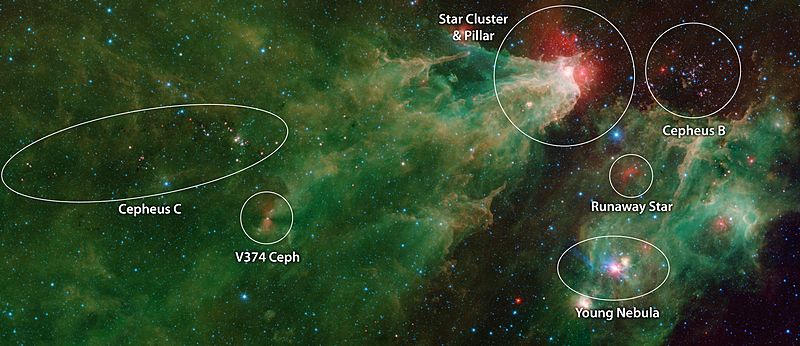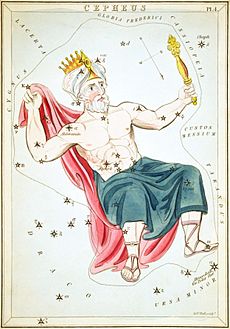Cepheus (constellation) facts for kids
| Constellation | |

List of stars in Cepheus
|
|
| Abbreviation | Cep |
|---|---|
| Genitive | Cephei |
| Pronunciation | or genitive |
| Symbolism | the King/King Cepheus |
| Right ascension | 20h 01m 56.4481s–09h 03m 19.7931s |
| Declination | 88.6638870°–53.3532715° |
| Area | 588 sq. deg. (27th) |
| Main stars | 7 |
| Bayer/Flamsteed stars |
43 |
| Stars with planets | 1 |
| Stars brighter than 3.00m | 1 |
| Stars within 10.00 pc (32.62 ly) | 3 |
| Brightest star | α Cep (Alderamin) (2.45m) |
| Messier objects | 0 |
| Meteor showers | 0c |
| Bordering constellations |
Cygnus Lacerta Cassiopeia Camelopardalis Draco Ursa Minor |
| Visible at latitudes between +90° and −10°. Best visible at 21:00 (9 p.m.) during the month of November. |
|
Cepheus is a constellation you can find in the far northern sky. It's named after King Cepheus, a king from Greek mythology. This constellation was first listed by the astronomer Ptolemy way back in the second century. Today, it's still one of the 88 recognized constellations.
The brightest star in Cepheus is Alpha Cephei, which shines with a brightness of 2.5. Another important star is Delta Cephei. It's a special type of star called a Cepheid variable. Some of the biggest stars we know are also in Cepheus, like RW Cephei, Mu Cephei, and VV Cephei.
Cepheus also holds a super bright quasar called S5 0014+81. This quasar has an incredibly huge black hole at its center. This black hole is about 40 billion times bigger than our Sun! It's one of the most massive black holes ever found.
Contents
History and Mythology
In Greek myths, King Cepheus ruled the land of Aethiopia. He was married to Queen Cassiopeia. They had a daughter named Andromeda. All three of them – Cepheus, Cassiopeia, and Andromeda – are now constellations in the night sky.
Stars and Features
Brightest Stars in Cepheus
Alpha Cephei, also called Alderamin, is the brightest star in the constellation. It has a brightness of 2.51.
Delta Cephei is a very famous star. It's a yellow supergiant star about 980 light-years away from Earth. In 1784, scientists discovered that its brightness changes. It goes from a brightness of 3.5 to 4.4 over about 5 days and 9 hours. Stars like Delta Cephei are called Cepheid variables. They are special because they pulsate, meaning they get bigger and smaller. Delta Cephei, for example, changes from 40 to 46 times the size of our Sun. It's also a double star, meaning it has a smaller blue star orbiting it.
Giant Stars in Cepheus
There are three huge Red supergiant stars in Cepheus that you can see without a telescope.
- Mu Cephei is known as Herschel's Garnet Star because of its deep red color. Its brightness changes over about 2 years. This star is enormous, about 5.64 times the distance from the Earth to the Sun in radius! If it were in the center of our Solar System, it would reach all the way to the orbit of Jupiter.
- VV Cephei A is another red supergiant. It's at least 5,000 light-years away. It's paired with a blue star called VV Cephei B. This star is one of the largest in our galaxy, with a diameter 1,400 times bigger than the Sun!
- T Cephei is also a red giant. Its brightness changes over 13 months. It's about 685 light-years from Earth and its size changes from 329 to 500 times the diameter of our Sun.
Double Stars in Cepheus
Cepheus has several double stars and binary stars.
- Omicron Cephei is a binary star system. It takes 800 years for the two stars to orbit each other. This system is 211 light-years from Earth. It has an orange main star and a smaller companion star.
- Xi Cephei is another binary star, 102 light-years from Earth. Its two stars take 4,000 years to orbit each other. It has a blue-white main star and a yellow companion.
Kruger 60 is a binary star system made of two red dwarf stars. It's one of the closest star systems to Earth, only 13 light-years away.

Deep-Sky Objects
- NGC 188 is an open cluster of stars. It's special because it's the closest open cluster to the North Star, and it's also one of the oldest known open clusters.
- NGC 6946 is a spiral galaxy often called the Fireworks Galaxy. Ten supernova explosions have been seen in it, which is more than in any other galaxy!
- The NGC 7023 is a beautiful reflection nebula that has a star cluster inside it. It's about 1,400 light-years from Earth.
- S 155, also known as the Cave Nebula, is a faint and spread-out nebula. It's part of a larger area of gas and dust in space.
- The quasar 6C B0014+8120 is one of the most powerful objects in the universe. It's powered by a supermassive black hole that is as massive as 40 billion Suns!
How Cepheus is Pictured
Cepheus is often shown with his arms raised, as if he is praying to the gods to save his daughter Andromeda. Sometimes, he is also shown as a king sitting on his throne.
Other Names and Meanings
In Chinese astronomy, the stars of Cepheus are part of two areas: the Purple Forbidden enclosure and the Black Tortoise of the North.
Things Named After Cepheus
- Two ships of the United States Navy were named after the constellation: USS Cepheus (AKA-18) and USS Cepheus (AK-265).
- An update for the video game Stellaris was called "Cepheus".
See also
 In Spanish: Cefeo (constelación) para niños
In Spanish: Cefeo (constelación) para niños





